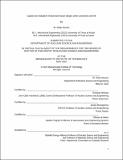Capital cost evaluation of advanced reactor designs under uncertainty and risk
Author(s)
Stewart, W. Robb
DownloadThesis PDF (6.418Mb)
Advisor
Shirvan, Koroush
Terms of use
Metadata
Show full item recordAbstract
Decarbonization incentives present an enormous market opportunity for the nuclear industry. To stay within the 1.5°C limit by 2050, across a range of scenarios, the IPCC forecasted a 2.5x average increase in global nuclear generation. High capital costs and the risk of overruns and delays may prevent the industry from realizing this new potential. Recent nuclear projects in the U.S. and Europe have averaged cost overruns more than 2x the original estimate. However, new reactor architectures are under development, and they may solve some or all elements of the cost problem. These new architectures leverage modularization, intra-plant learning rates, passive safety, advanced construction, and advanced manufacturing in their endeavor to lower capital costs. This thesis systematically analyzes the cost saving potential of these strategies for eight unique reactor architectures. The aim was to understand which architectures and strategies have the greatest potential to reduce cost and risk to cost overruns, and then, apply that understanding to help utilities, policymakers, and other stakeholders in investment decision making and long-term planning.
Total capital costs include direct costs, indirect costs, and financing costs, each based on several uncertain parameters and processes. The first section of this thesis presents a bottom-up methodology for estimating direct and indirect costs of nuclear plants to estimate an overnight cost that does not include the construction schedule and its impact on cost. The method scaled a set of reference costs from the Economic Energy Data Base for nuclear projects. The methodology featured novel components and technologies, such as standalone steel containments, e-beam welded vessels, steel plate composites, and structural and system modules. Of these technologies, advanced construction techniques such as steel plate composites were not effective in reducing the overnight direct costs, but advanced vessel manufacturing technologies were highly impactful especially for small- and multi-module architectures with heavy use of steel vessels with cost reduction up to 9% of overnight cost. Passive safety systems usually required new, expensive structures that offset the cost reduction in other systems including electrical and safeguards systems. Modularization did not substantively reduce the overnight construction costs, but it increased the impact of learning-by-doing for sequentially deployed plants. Learning-by-doing was one of the most effective cost reduction strategies, reducing capital costs 30-45%.
The second section of this thesis presents a methodology to estimate the construction duration of a reactor architecture given the specific shape factor constraints to that architecture, local labor supply, and set of site activities and ordered dependencies. Interest accrued during construction is significant for nuclear projects because they have very long construction durations. Large reactor architectures were very sensitive to the local labor market conditions and experienced long delays (40-50%) when the labor pool was insufficient. Small reactors were more robust to labor conditions with negligible delays. Both large and small architectures can, in theory, deliver projects in 30-40 months depending on the level of structural modularization. Modularization can dramatically reduce the construction duration and associated financing costs for both large and small reactors 65-75% which was 15-25% of all total costs.
Capital cost estimation is a highly uncertain process, particularly for nuclear projects, and the literature contains conflicting guidelines for scaling the costs of certain components. Further, the proposed modularization, learning, and indirect cost models built are subject to much uncertainty as well. The third section of this thesis quantified the uncertainty of the overnight cost estimates. Indirect costs were a significant source of uncertainty for all reactor architectures. Learning-by-doing cost reductions were also a large contributor to uncertainty for all architectures but especially the multi-module plants where there was intra-plant learning. Input data, specifically commodity volumes such as concrete and steel, were a large source of uncertainty as well. Typical first-of-a-kind costs had +/- 10% uncertainty at the 95% confidence interval, and +/20% for 10th-OAK projects.
The final section reviews the specific construction delay drivers for the Vogtle Units 3 & 4 project. This case study provided input data for supply chain delay and change order risks. Human error risks were also modeled using data from other large megaprojects. Change order and human error risk were the dominant drivers of construction delays, with supply chain delays having a small effect. Most of the cost and schedule risk were mitigated after the first-of-a-kind project. Smaller projects were not immune to the construction schedule risks and delays seen in large nuclear projects, but they were able to overcome the risks with a smaller absolute cost project. Therefore, for equal size capacity deployments (i.e. several small reactors vs. fewer large reactors), smaller reactor architectures had narrower cost distributions and lower risk to cost overrun. Smaller reactor cost escalation extended 10-11% ($700-800/kWe) above the median cost overrun, but larger reactor escalations extended 16-24% ($1,100-2,200/kWe) above the median cost overrun. However, these lower risks did not usually translate to lower median costs. By providing cost and risk to cost overrun estimates for the leading nuclear power plant architectures, this thesis work can better inform the utilities and policy makers on economics of nuclear energy and most effective technological pathways to improve its attractiveness.
Date issued
2022-05Department
Massachusetts Institute of Technology. Department of Nuclear Science and EngineeringPublisher
Massachusetts Institute of Technology